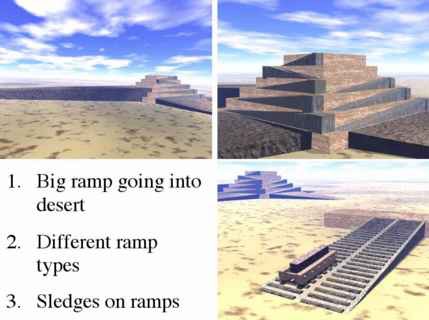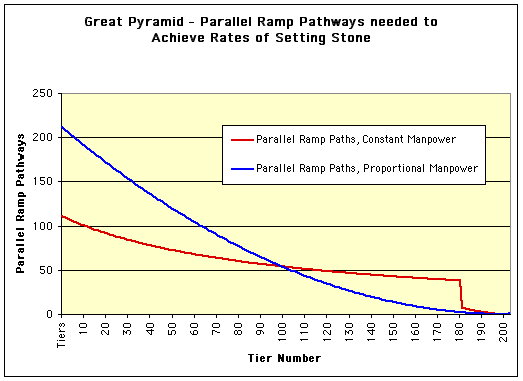Extracts from a new book,
"The Pyramid Builder's Handbook"
by
Derek K Hitchins©
Full copyright and intellectual property rights retained
Many people believe that the ancient Egyptians used ramps to haul stone up pyramids during the building process. Ramps have been found in association with quarries, and with some pyramids, but controversy surrounds the role, if any, of the ramp in constructing the Great Pyramid, if only because of its vast size. The graphic shows views from a virtual reality flyaround, presenting different kinds of ramp which might have been used.

- A desert ramp stretches out into the desert, top left
- Closer up, three kinds of ramp can be seen on the pyramid
- a desert ramp, which interferes / is incompatible with other ramp types
- a helical ramp, starting in one corner going up one face, rounding the corner and continuing up the next face, and so on. Up to 4 helical ramps might be envisaged operating simultaneously from the 4 corners
- a zig-zag ramp, going to and fro up one face rather like a cyclist zig-zags when climbin g a steep hill
- Notice the large amount of maneouvering room left at each corner.
- If a stone were being hauled on a sledge pulled by ropes, the men, ropes and sledge would stretch out as much as 33m, making it difficult to navigate around a sharp bend. Hence the corners would have to be substantial
- Note, too, that ramps have a limited upward slope, beyond which it would be too difficult to haul stone. The Anastasi Papyrus suggests this upper limit to have been some 8 degrees
- higher up the pyramid, the length of the ramp on any face becomes shorter as the face narrows, until the ramp is too short to reach the next step
- either ramps do not work above this limit, or the steps would need to be made smaller
- in fact, steps are smaller higher up on some pyramids, but this could also be to reduce the weight of stones to be carried to greater heights

We can dispense with the desert ramp without too much ceremony. As the pyramid grows, so too must the desert ramp, and it very rapidly outstrips teh pyramid is supposed to be helping to build! The graph shows the situation for either Khafre's or Khufu's pyramid. At ess than 60m, the desert ramp would have become quite uneconomic and impractical.
No such barrier stands in the way of either the helical or zig-zag ramps. In their case, the issue is their ability to support and sustain the very high rates of setting stone that would be needed:

This graph is a repeat of that shown on the Pyramid Calculator page, where the surprising figures are explained and justified. It seems unbelievable that such rates of setting stone could be achieved, 10 hours per day,let alone sustained as the pyramid was erected, and the ramps were being continually maintained and extended. Note also that, during the corvée, the rates of setting stone would of necessity be up to 4 times higher than shown for the mean rate, to account for the bulk of the year's work being compressed into the 3 months of the Inundation.

If the corvée did occur each year, then the number of parallel pathways required to convey stone on sledges up the ramp or ramps is shown in the graph, assuming either of the two manning strategies shown in the graph legend. We are not talking about the single pathway ramp curling lazily around the pyramid, with the odd stone being hauled occasionally - that's Hollywood. Instead it seems that we are talking about a multilane highways, jam-packed with head-to-tail sledge teams, and with other teams maintaining and extending the ramps, perhaps overnight or during the midday break.
There are some potential ways of reducing the problems facing the ramp theories. Perhaps many of the stones were much less than the 2.5tonnes average, and could actually be lifted by 1 to four men. In such cases it might possible to increasse the effective capacity per pathway, and so to reduce the number of pathways.
One of the features associated with ramps that is missing w.r.t. the Giza Pyramids is ramp remains. There are remains of the ramp used to drag the stones from the quarry up to the Great Pyramid. But there is none for the pyramids themselves, and the remains of massive ramps would be hard to miss, unless...
Just one thought occurs. Suppose the ramps had to be so massive to support the phenomenal rate and weight of stone traffic that, instead of dismantling, it was easier and quicker to simply build the ramps in to the overall pyramid structure at the end, under the packing stones. Could that work?
No matter which way you turn, you end up finding yourself trying too hard to justify the ramp theory. Perhaps it is time to face facts, and find a better theory.